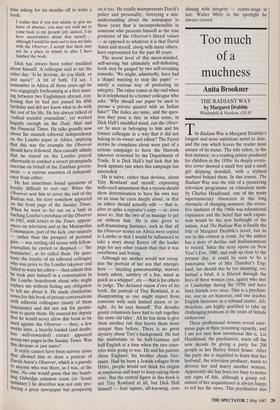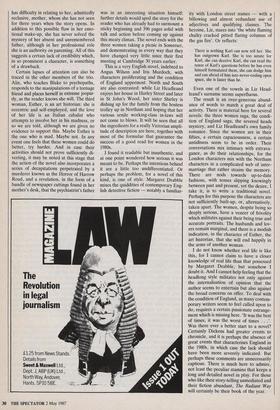Too much of a muchness
Anita Brookner
THE RADIANT WAY by Margaret Drabble
Weidenfeld & Nicolson, £10.95
The Radiant Way is Margaret Drabble's longest and most ambitious novel to date, and the one which leaves the reader most unsure of its status. The title refers, in the first instance, to a reading primer produced for children in the 1930s: its deeply evoca- tive cover showed a small boy and a small girl skipping downhill, with a stylised sunburst behind them. In due course, The Radiant Way was the title of a pioneering television programme on education made by Charles Headleand, one of the many supernumerary characters in this long chronicle of changing manners: the evoca- tive sunburst of the 1960s was educational expansion and the belief that such expan- sion would be the new birthright of the nation. And The Radiant Way is finally the title of Margaret Drabble's novel, but its use in this context is ironic, for the author has a story of decline and disillusionment to record. Since the story opens on New Year's Eve, 1980, and ends up close to the present day, it could be seen to be a panoramic view of Mrs Thatcher's Eng- land, but should this be too daunting, too factual a brief, it is filtered through the lives of three women (yes, again) who met at Cambridge during the 1950s and have been friends ever since. One is a psychiat- rist, one an art historian, and one teaches English literature in a remand centre. All, therefore, are highly qualified to take up challenging positions in the years of female endeavour.
These professional women reveal enor- mous gaps in their reasoning capacity, and I am not sure how intentional this is. Liz Headleand, the psychiatrist, starts off the new decade by giving a party for 200 people in her Harley Street house. After the party she is stupefied to learn that her husband, the television producer, wants to divorce her and marry another woman. Apparently she has been too busy to notice any signs of this, although a gossip col- umnist of her acquaintance is always happy to tell her the news. This psychiatrist also has difficulty in relating to her, admittedly reclusive, mother, whom she has not seen for three years when the story opens. In addition to this possible flaw in her emo- tional make-up, she has never solved the mystery of her absent and unremembered father, although in her professional role she is an authority on parenting. All of this suggests a certain lack of credibility which, in so prominent a character, is something of a drawback.
Certain lapses of attention can also be traced in the other members of the trio. Alix, who teaches Blake to psychopaths, responds to the manipulations of a teenage friend and places herself in extreme jeopar- dy, as the reader knows she will. The third woman, Esther, is an art historian: she is eccentric and self-employed, and the love of her life is an Italian cabalist who attempts to involve her in his madness, or so we are told, although we are given no evidence to support this. Maybe Esther is the one who is mad. Maybe not. In any event one feels that these women could do better, try harder. And in case their activities should not prove sufficiently di- verting, it may be noted at this stage that the action of the novel also incorporates a series of decapitations perpetrated by a murderer known as the Horror of Harrow Road, and a revelation, in the form of a bundle of newspaper cuttings found in her mother's desk, that the psychiatrist's father was in an interesting situation himself: further details would spoil the story for the reader who has already had to surmount a sticky beginning and 396 pages solid with talk and action before coining up against this meaty climax. The novel ends with the three women taking a picnic in Somerset, and demonstrating in every way that they have changed very little since their first meeting at Cambridge 30 years earlier.
This is a very English novel, indebted to Angus Wilson and Iris Murdoch, with characters proliferating and the condition of England uppermost. North and South are also contrasted: while Liz Headleand enjoys her house in Harley Street and later in St John's Wood, her sister Shirley is dishing up for the family from the hostess trolley up in Northam and hoping that her various senile working-class in-laws will not come to blows. It will be seen that all the ingredients for a really Victorian ampli- tude of description are here, together with most of the formulae that guarantee the success of a good read for women in the 1980s.
I found it readable but inauthentic, and at one point wondered how serious it was meant to be. Perhaps the intentions behind it are a little too undifferentiated. Or perhaps the problem, for a novel of this kind, is one of style. Margaret Drabble mixes the quiddities of contemporary Eng- lish detective fiction — notably a familiar- ity with London street names — with a billowing and almost redundant use of adjectives and qualifying clauses. The heroine, Liz, stares into the white flaming chalky cracked pitted flaring columns of the gas fire'. Or reflects:
There is nothing Karl can now tell her. She has outgrown Karl. She is too astute for Karl, she can deceive Karl, she can read the tenor of Karl's questions before he has even himself formulated them, she can dodge him and run ahead of him into never-ending open space, she is faster than he.
Even one of the vowels in Liz Head- leand's surname seems superfluous.
The result is an over-generous abund- ance of words to match a great deal of activity. There is material here for several novels: the three women saga, the condi- tion of England saga, the severed heads mystery, and Liz Headleand's own family romance. Since the women are in their fifties, a certain capaciousness, a certain untidiness seem to be in order. Their conversations mix intimacy with extrava- gance, as do their relationships, for the London characters mix with the Northam characters in a complicated web of inter- marriage that rather strains the memory. There are nods towards up-to-date fashions, with tenses slipping knowingly between past and present, yet the desire, I take it, is to write a traditional novel. Perhaps for this purpose the characters are not sufficiently built-up, or, alternatively, taken apart. The women, despite being so deeply serious, have a veneer of frivolity which militates against their being true and accurate portraits. The husbands and lov- ers remain marginal, and there is a modish indication, in the character of Esther, the art historian, that she will end happily in the arms of another woman.
I do not know whether real life is like this, for I cannot claim to have a closer knowledge of real life than that possessed by Margaret Drabble, but somehow I doubt it. And I cannot help feeling that the headlong style militates not only against the internalisation of opinion that the author seems to entertain but also against the broad concerns on offer. To deal with the condition of England, as many contem- porary writers seem to feel called upon to do, requires a certain passionate estrange- ment which is missing here. 'It was the best of times, it was the worst of times . . Was there ever a better start to a novel? Certainly Dickens had greater events to chronicle, and it is perhaps the absence of great events that characterises England in the 1980s, in which case the lack should have been more severely indicated. But perhaps these comments are unnecessarily captious. There is much here to admire, not least the peculiar stamina that keeps a long and detailed novel in play. For those who like their story-telling unmediated and their fiction abundant, The Radiant Way will certainly be their book of the year.



















































 Previous page
Previous page